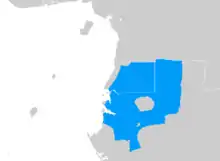Fang language
Fang /ˈfɒŋ/ is a Central African language spoken by around 1 million people, most of them in Equatorial Guinea, and northern Gabon, where it is the dominant Bantu language; Fang is also spoken in southern Cameroon, the Republic of the Congo, and small fractions of the islands of São Tomé and Príncipe. It is related to the Bulu and Ewondo languages of southern Cameroon.
| Fang | |
|---|---|
| Pangwe | |
| Faŋ, Paŋwe | |
| Native to | Equatorial Guinea, Gabon, Republic of the Congo, Cameroon, and São Tomé and Príncipe |
| Ethnicity | Fang |
Native speakers | 1 million (2006–2013)[1] |
| Dialects |
|
| Language codes | |
| ISO 639-2 | fan |
| ISO 639-3 | fan |
| Glottolog | fang1246 |
A.75,751[2] | |
 | |
Under President Macías Nguema, Fang was the official language of Equatorial Guinea. There are many different variants of Fang in northern Gabon and southern Cameroon. Maho (2009) lists Southwest Fang as a distinct language. The other dialects are Ntoumou, Okak, Mekê, Atsi (Batsi), Nzaman (Zaman), Mveni, and Mvaïe.
Corpus and lexicology
Despite Fang's lack of any well-defined literary corpus, it is of note that linguists have, in the past, made attempts to compile dictionaries and lexicons for the Fang language. The two most notable ones to be proposed or fully compiled were made by Maillard (2007)[3] and Bibang (2014). Neither created a direct Fang-English dictionary, but opted instead to separate the two languages via a third European language as a bridge for various loanwords.
The translation efforts to English have been done through Romance languages: specifically, Spanish and French. The latter of the two languages would likely have had the most impact on the language, given the occupation of Gabon by the French during the existence of French Equatorial Africa (itself part of French West Africa), which lasted 75 years from 1885 to 1960. To a lesser extent, in São Tomé and Príncipe, Portuguese also likely has influenced the dialects of Fang present there, due to the country being occupied by Portugal for most of the islands' history of habitation.
Phonology[4]
Vowels
Fang has 7 vowels, each of which can have short or long realizations.
| Front (short/long) | Back (short/long) | |
|---|---|---|
| Close | i iː (ĩ) | u uː (ũ) |
| Close-mid | e eː (ẽ) | o oː (õ) |
| Open-mid | ɛ ɛː (ɛ̃) | ɔ ɔː (ɔ̃) |
| Open | a aː (ã) | |
Nasal vowels are allophones of the respective oral vowels, when followed by a nasal consonant [ŋ] or [ɲ]. Words can not start with [ɛ], [i], [ɔ] nor [u].
Diphthongs
Diphthongs can be a combination of any vowel with [j] or [w], as well as [ea], [oe], [oa], [ua].
Tone
Fang distinguishes between 4 different tones, conventionally called: high, low, rising and falling. The former two are simple tones, while the latter are compound tones. One vowel in a sequences of vowels can be elided in casual speech, though its tone remains and attaches to the remaining vowel. [5]
Consonants
In Fang, there are 24 plain consonants. The majority of them can become prenasalized:
| Labial | Dental | Alveolar | Alveopalatal | Velar | Glottal | |
|---|---|---|---|---|---|---|
| Nasal | m | n | ɲ | ŋ | ||
| Stop | p b mp mb |
t d nt nd |
k ɡ ŋk ŋg k͡p ɡ͡b ŋk͡p ŋɡ͡b |
ʔ | ||
| Affricate | t͡s d͡z nt͡s nd͡z |
|||||
| Fricative | f v ɱf ɱv |
s z ns nz |
h | |||
| Approximant | l | j ɲj |
w nw |
|||
| Tap | ɾ |
/h/ is only used in interjections and loanwords.
Words can not start with /ŋ/, except when followed by a velar consonant. /ɾ/ and /z/ also are restricted from word-initial position. /g/ and /p/ can only come in word-initial position in words of foreign origin, although in many of these cases, /g/ becomes realized as [ŋg].
The morpheme "gh" is pronounced as ɾ in the case of the word "Beyoghe" (the Fang term for Libreville); one of several changes to pronunciation by morphology.
It is also important to note that in Fang, at every "hiatus" (shock of two vowels), such as in "Ma adzi", it is required for one to make the second word an aphetism, dropping the pronunciation of the aː sound at the start of the second word (e.g. "Ma dzi") in order to make grammatically correct sentences.
See also
References
- Fang at Ethnologue (18th ed., 2015)
- Jouni Filip Maho, 2009. New Updated Guthrie List Online
- Ella, Edgar Maillard (2007-03). A Theoretical Model For a Fang-French-English Specialized Multi-Volume School Dictionary.
- Bibang Oyee, Julián-Bibang (2014). Diccionario Español-Fang/Fang-Español. Akal.
- Bibang Oyee, Julián (1990). Curso de lengua fang. Centro Cultural Hispano-Guineano
External links
- Bantulanyi
- http://scholar.sun.ac.za/handle/10019.1/1229
- https://web.archive.org/web/20080630064631/http://monefang.com/parlons1.html Monefang, archived from the original (2008). Note: This site is mostly in French.
- https://www.acsu.buffalo.edu/~jcgood/Mve-2013-Fang.pdf